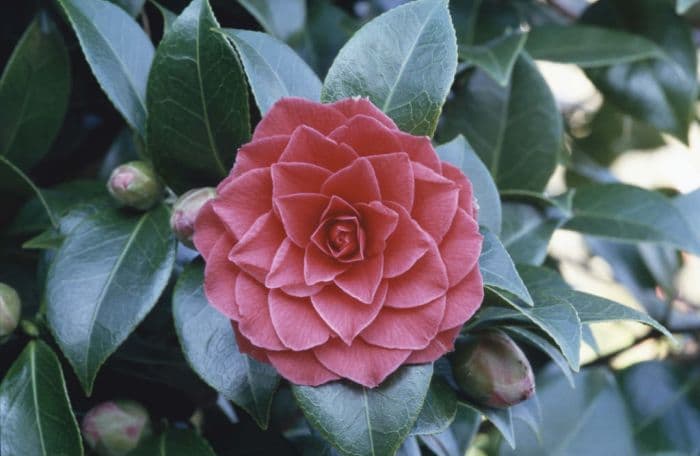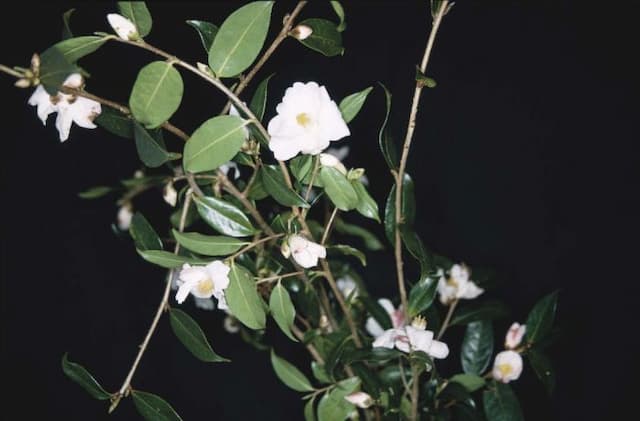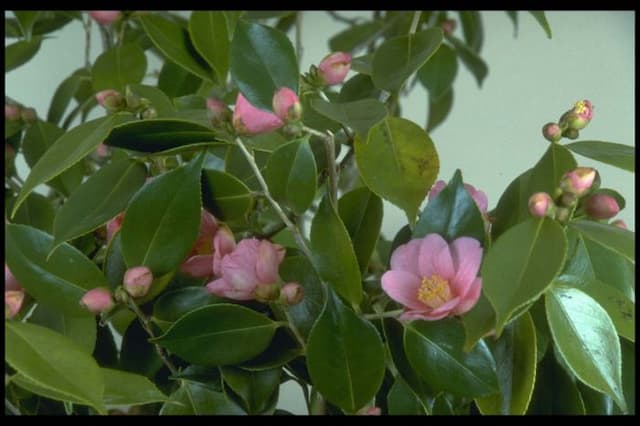Black Lace Camellia Camellia 'Black Lace'

ABOUT
Camellia 'Black Lace' is a striking plant known for its distinctive deep red to purplish-black flowers that resemble elegant, old-fashioned rose blooms. These luxurious flowers are typically large and showy, with a multitude of overlapping petals that create a full, ruffled appearance. At the center of each bloom, a cluster of bright yellow stamens offers a stark contrast to the dark petals, providing an alluring focal point. The foliage of Camellia 'Black Lace' is equally attractive, featuring glossy, dark green leaves that present a robust and leathery texture. These leaves are oval-shaped with pointed tips and are arranged alternately along the stems, providing a lush backdrop for the dramatic blossoms. As the seasons change, the flowers stand out against the evergreen foliage, lending year-round interest to garden settings. The plant typically blooms during the cooler months, offering a burst of color when many other plants are dormant. The overall aesthetic of Camellia 'Black Lace' is one of elegance and sophistication, making it a coveted choice for ornamental gardens.
About this plant
 Names
NamesFamily
Theaceae
Synonyms
Black Lace Camellia, Black Lace Sasanqua
Common names
Camellia 'Black Lace'.
 Toxicity
ToxicityTo humans
The common name for Camellia 'Black Lace' is simply Camellia. Camellias are not commonly known to be toxic to humans. However, as with any plant not typically meant for consumption, it's possible some individuals may experience mild gastrointestinal upset or an allergic reaction if they ingest parts of the plant.
To pets
For Camellia, the situation in pets is similar to humans. This plant is not generally considered toxic to pets such as dogs and cats. Nonetheless, if a pet ingests a significant amount of the plant, it might experience mild gastrointestinal distress, such as vomiting or diarrhea. It's always best to prevent pets from eating ornamental plants, as individual sensitivities can vary.
 Characteristics
CharacteristicsLife cycle
Perennials
Foliage type
Evergreen
Color of leaves
Dark green
Flower color
Red
Height
6-8 feet (1.8-2.4 meters)
Spread
4-6 feet (1.2-1.8 meters)
Plant type
Shrub
Hardiness zones
7
Native area
Asia
Benefits
 General Benefits
General Benefits- Ornamental Value: Camellia 'Black Lace' produces beautiful, dark red to nearly black flowers that make it a striking ornamental plant in gardens and landscaping.
- Long Blooming Season: This variety of camellia typically has a long blooming season, providing color and interest in the garden for an extended period.
- Ease of Care: Camellias are generally low-maintenance plants, requiring minimal pruning and care once established.
- Evergreen Foliage: As an evergreen shrub, the Camellia 'Black Lace' provides year-round foliage, maintaining garden interest even when not in bloom.
- Shade Tolerance: This plant can tolerate partial shade, making it versatile for different garden settings where other flowering plants may not thrive.
- Privacy Screen: When planted in groups or rows, Camellia 'Black Lace' can create a dense and attractive privacy screen for homes or garden areas.
 Medical Properties
Medical PropertiesThis plant is not used for medical purposes.
 Air-purifying Qualities
Air-purifying QualitiesThis plant is not specifically known for air purifying qualities.
 Other Uses
Other Uses- Ink Production: The dark petals of Camellia 'Black Lace' can be used to create a natural dye, which artists and crafters might use to produce eco-friendly inks.
- Photography: The striking dark flowers serve as an excellent subject for botanical photography, showcasing the unique beauty of this variety.
- Educational Tool: Botany educators can use Camellia 'Black Lace' to teach about plant genetics and the cultivation of new plant varieties.
- Culinary Garnish: Although not widely known for edibility, the distinctive dark blooms could be used as an ornamental garnish for their visual impact on avant-garde cuisine.
- Thermal Indicators: The blooms of Camellia 'Black Lace' may change intensity with temperature; thus, they could be used for simple climate studies or demonstrations in gardens.
- Art Supplies: Petals can be used in crafting for making homemade paper or adding natural elements to mixed media art pieces.
- Fashion Inspiration: The unique coloration of Camellia 'Black Lace' can inspire textile patterns and designs for fashion, particularly in floral-themed clothing lines.
- Eco-friendly Confetti: Dried petals can serve as biodegradable confetti for events such as weddings or parties, providing an environmentally friendly alternative to traditional paper or plastic products.
- Floristry Studies: This plant is ideal for floristry students to learn about the handling and care of unique and delicate flowers in arrangements and bouquets.
- Color Therapy: The intense dark coloration can be used in color therapy practices for those who find deep, rich hues calming or grounding.
Interesting Facts
 Feng Shui
Feng ShuiThe Camellia is not used in Feng Shui practice.
 Zodiac Sign Compitability
Zodiac Sign CompitabilityThe Camellia is not used in astrology practice.
 Plant Symbolism
Plant Symbolism- Admiration: The Camellia 'Black Lace' is often associated with deep admiration towards someone, owing to its delicate yet striking appearance.
- Perfection: The lush, flawless blooms represent an ideal or perfection that one might strive to achieve or appreciate.
- Longevity: Camellias are known for their longevity both as plants and in their flowering season, symbolizing a long and prosperous life.
- Love: The rich, sensual coloring of the 'Black Lace' variety can symbolize deep and passionate love, much like red roses.
- Refinement: The plant’s elegant form and growth habit give it an air of sophistication and refinement.
 Water
WaterThe Japanese Camellia, commonly known as Camellia 'Black Lace', should be watered deeply to ensure the roots receive ample moisture; however, allow the soil to slightly dry between waterings. They prefer consistently moist soil, so watering once a week with approximately 1 to 1.5 gallons of water is generally suitable. During peak summer months or in dryer climates, frequency may increase to twice a week. In contrast, reduce watering to every other week in the cooler season or if rainfall is sufficient to maintain soil moisture. Overwatering can lead to root rot, so it's essential to monitor the soil's dampness before watering.
 Light
LightThe best light conditions for the Japanese Camellia involve placing it in a location with partial shade where it can receive some dappled sunlight. It thrives when protected from hot afternoon sun, which can scorch the leaves. A spot that enjoys morning light and afternoon shade is ideal for the health and bloom of the Camellia 'Black Lace'.
 Temperature
TemperatureJapanese Camellia grows best in temperature ranges between 40 to 85 degrees Fahrenheit. They can survive minimal dips below 32 degrees Fahrenheit but should be protected from prolonged freezing temperatures. The ideal temperature conditions for the vibrant growth and flowering of Camellia 'Black Lace' are moderate climates that do not frequently experience extreme heat or cold.
 Pruning
PruningPruning the Japanese Camellia is crucial to maintain shape, remove dead or weak growth, and encourage blossoming. Prune after flowering in spring to shape the plant and remove any branches that disrupt the desired form. Thinning out dense areas will improve airflow and light penetration. Annual pruning is often sufficient to keep the Camellia 'Black Lace' looking its best.
 Cleaning
CleaningAs needed
 Soil
SoilThe Camellia 'Black Lace', commonly known as Sasanqua Camellia, thrives best in a well-draining, acidic soil mix with a pH between 5.5 and 6.5. A mix containing 1/3 acidic organic matter such as pine bark, 1/3 peat moss, and 1/3 perlite or coarse sand is ideal. Ensuring the soil is rich in organic material will help retain moisture while allowing excess water to drain.
 Repotting
RepottingSasanqua Camellias generally need repotting every 2-3 years to ensure they are not becoming root-bound and to refresh the soil. However, these plants prefer not to be disturbed too often, so repotting should be done cautiously and only when necessary.
 Humidity & Misting
Humidity & MistingSasanqua Camellias enjoy moderate to high humidity levels; aiming for 50-60% is beneficial for optimal growth. These plants can suffer in very dry air, so maintaining a stable humidity is crucial.
 Suitable locations
Suitable locationsIndoor
Provide bright, indirect light and ensure high humidity for Sasanqua Camellia.
Outdoor
Plant in partial shade in acid soil; shelter from strong winds for Sasanqua Camellia.
Hardiness zone
7-9 USDA
 Life cycle
Life cycleThe life of the Camellia 'Black Lace', also commonly known as Black Lace Camellia, begins with germination, which occurs when conditions of moisture, temperature, and light are favorable for the seed to sprout. It proceeds to the seedling stage, where it develops its first true leaves and establishes a root system. As it enters the vegetative stage, the Black Lace Camellia grows in size and forms a bushy structure with glossy, dark green leaves, eventually becoming mature enough to initiate the budding process. Flowering occurs typically in the fall or winter, depending on the climate, where it showcases its distinctive dark red to black flowers with a ruffled appearance. After pollination, the flowers develop into seed capsules that mature, dry, and release seeds to begin the cycle anew. Throughout its life, the Black Lace Camellia requires attention to pruning, soil conditions, and adequate watering to thrive and repeat its life cycle successfully.
 Propogation
PropogationPropogation time
Spring-Early Summer
Propogation: Camellia 'Black Lace', popular for its dark, dramatic foliage and stunning floral display, is typically propagated through semi-hardwood cuttings. This method is most successful when performed in late summer or early fall, following the seasonal cycle of the plant when growth has slowed and stems are maturing. To propagate, a cutting of about 4 to 6 inches (10 to 15 centimeters) is taken from a healthy, non-flowering branch, ensuring it has several leaf nodes. The lower leaves are removed, and the cut end may be treated with a rooting hormone to encourage root development. Then, the cutting is placed in a potting mix with good drainage, kept moist, and covered with a plastic bag or placed in a greenhouse to maintain a humid environment. This setup provides the necessary conditions for the cutting to develop roots, usually within several weeks to a few months, after which it can be transferred to a larger pot or into the garden.









